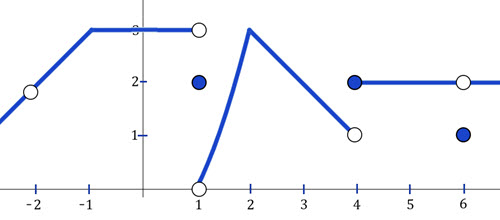Andymath.com features free videos, notes, and practice problems with answers! Printable pages make math easy. Are you ready to be a mathmagician?
\(\textbf{1)}\) \( \displaystyle \lim_{x\to3} \frac{x-3}{x^2-9} \)
\(\textbf{2)}\) \( \displaystyle \lim_{x\to5} \frac{5-x}{x^2-25} \)
\(\textbf{3)}\) \( \displaystyle \lim_{x\to 0} \frac{x^2+2x}{x} \) 
\(\textbf{4)}\) \( \displaystyle \lim_{x\to -1} \frac{x^2+5x+4}{x^2+4x+3} \)
\(\textbf{5)}\) \( \displaystyle \lim_{x\to 1} \frac{x^3-1}{x-1} \)
\(\textbf{6)}\) \( \displaystyle \lim_{x\to3} \frac{x^2-1}{x^3-1} \)
\(\textbf{7)}\) \( \displaystyle \lim_{x\to 4} \frac{4x-x^2}{2-\sqrt{x}} \)
\(\textbf{8)}\) \( \displaystyle \lim_{x\to 3} \frac{3x}{x^2+2} \)
\(\textbf{9)}\) \( \displaystyle \lim_{x\to 3} \frac{\frac{1}{x}-\frac{1}{3}}{x-3} \)
\(\textbf{10)}\) \( \displaystyle \lim_{x\to 0} \frac{1-\sqrt{1-x}}{x} \)
See Related Pages\(\)
\(\bullet\text{ Limit Calculator}\)
\(\,\,\,\,\,\,\,\,\text{(Symbolab.com)}\)
\(\bullet\text{ Calculus Homepage}\)
\(\,\,\,\,\,\,\,\,\text{All the Best Topics…}\)
\(\bullet\text{ Limits on Graphs}\)
\(\,\,\,\,\,\,\,\,\) \(…\)
\(…\)
\(\bullet\text{ Continuity on Graphs}\)
\(\,\,\,\,\,\,\,\,\) \(…\)
\(…\)
\(\bullet\text{ Piecewise Functions- Limits and Continuity}\)
\(\,\,\,\,\,\,\,\,\) \(…\)
\(…\)
\(\bullet\text{ Limits at Infinity}\)
\(\,\,\,\,\,\,\,\,\displaystyle\lim_{x\to \infty}\frac{5x^2+2x-10}{3x^2+4x-5}…\)
\(\bullet\text{ Trig Limits}\)
\(\,\,\,\,\,\,\,\,\displaystyle \lim_{\theta\to0} \frac{\sin \theta}{\theta}=1…\)
In Summary
Limits is a fundamental concept in calculus that deals with the behavior of functions as they approach certain values. It allows us to understand and predict the behavior of functions as they approach infinity or as certain variables within the function approach certain values.
The definition of limits is a bit technical, but it can be thought of as a way to determine the value of a function at a specific point, even if the function itself is not defined at that point. This is done by considering the values of the function as it approaches the specific point from both sides.
We learn about limits because it is an essential concept in calculus and has numerous applications in fields such as physics, engineering, and economics. It allows us to understand and analyze the behavior of functions in a way that would not be possible without it.
Limits are typically introduced in Calculus courses.
Common mistakes with limits usually occur when evaluating limits that involve infinite or indeterminate forms.
Limits were first developed and formalized by Newton and Leibniz in the 17th century.
Math topics that use limits include derivatives, which are used to measure the rate of change of a function, and integrals, which allow us to find the area under a curve. Both of these concepts are also essential in calculus.
Some math topics that use intro to limits
Derivatives: Limits are a key concept in the definition of the derivative, which is a measure of the instantaneous slope of a function at a particular point. This is found by taking the limit as the change in x approaches zero.
Continuity: A function is continuous at a point if, roughly speaking, it does not have any “breaks” or “jumps” at that point. This idea can be made precise using limits: a function is continuous at a point if the limit of the function as the input approaches that point from both sides is equal to the value of the function at that point.
Integration: Integration is a way of finding the area under a curve or the volume of a three-dimensional object by dividing it into smaller pieces and adding them up. One way to do this is by using limits, which allow us to calculate the area or volume of the object by taking the limit as the size of the pieces approaches zero.
Asymptotes: An asymptote is a line that a curve approaches as it extends indefinitely in some direction. For example, the graph of the function \(y = \frac{1}{x^2}\) has a vertical asymptotes at x = 0, because the function becomes arbitrarily large as x approaches 0 from the left or right. Asymptotes can be analyzed using limits.
About Andymath.com
Andymath.com is a free math website with the mission of helping students, teachers and tutors find helpful notes, useful sample problems with answers including step by step solutions, and other related materials to supplement classroom learning. If you have any requests for additional content, please contact Andy at tutoring@andymath.com. He will promptly add the content.
Topics cover Elementary Math, Middle School, Algebra, Geometry, Algebra 2/Pre-calculus/Trig, Calculus and Probability/Statistics. In the future, I hope to add Physics and Linear Algebra content.
Visit me on Youtube, Tiktok, Instagram and Facebook. Andymath content has a unique approach to presenting mathematics. The clear explanations, strong visuals mixed with dry humor regularly get millions of views. We are open to collaborations of all types, please contact Andy at tutoring@andymath.com for all enquiries. To offer financial support, visit my Patreon page. Let’s help students understand the math way of thinking!
Thank you for visiting. How exciting!